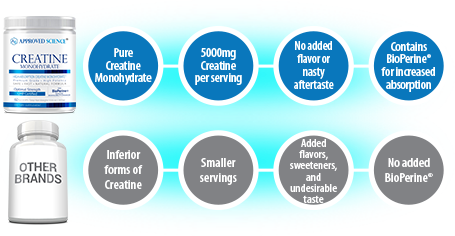Is Creatine Safe And Effective? A Detailed Analysis

Table of Contents
What is Creatine and How Does it Work?
Creatine is a naturally occurring compound primarily found in red meat and fish. Your body produces some creatine, but supplementation can significantly increase levels. Creatine's primary function is to enhance the production of adenosine triphosphate (ATP), the body's primary energy source, particularly during high-intensity activities. This increased ATP availability translates to improved muscle performance and strength.
Different types of creatine exist, with creatine monohydrate being the most researched and widely available form, boasting high bioavailability. Other forms, like creatine hydrochloride (HCL) or creatine ethyl ester, exist but may not offer significant advantages over monohydrate.
Key benefits often associated with creatine supplementation include:
- Increased strength and power output: Creatine boosts ATP levels, leading to more explosive movements and enhanced strength gains.
- Enhanced muscle growth (hypertrophy): By facilitating ATP production, creatine supports muscle protein synthesis, contributing to muscle growth.
- Improved high-intensity exercise performance: Creatine is particularly beneficial for short bursts of intense activity, like weightlifting or sprinting.
- Potential cognitive benefits: Some studies suggest potential cognitive enhancements, though more research is needed to solidify these findings. This area often involves creatine supplementation and brain function studies.
The Safety of Creatine Supplementation
Many myths surround creatine's safety. While some experience mild side effects, serious adverse reactions are rare in healthy individuals. Commonly reported side effects include water retention (leading to weight gain), gastrointestinal discomfort (such as bloating or nausea), and muscle cramps. However, these are generally mild and temporary, often resolving with proper hydration and adjustment of dosage.
Extensive research spanning decades supports the safety of creatine monohydrate for healthy adults. However, certain groups should consult a doctor before using creatine:
- Individuals with kidney issues: Pre-existing kidney conditions may warrant caution, necessitating medical supervision.
- Pregnant or breastfeeding women: The effects of creatine during pregnancy and breastfeeding aren't fully understood, so it's best to err on the side of caution.
- Individuals with specific medical conditions: Other underlying health conditions may interact with creatine supplementation; consult your physician.
Addressing specific safety concerns:
- Kidney function: Numerous studies have found no adverse effects on kidney function in healthy individuals using creatine appropriately.
- Liver function: Similarly, research indicates no negative impact on liver function in healthy populations.
- Dehydration: While not directly caused by creatine, dehydration can exacerbate potential side effects. Adequate hydration is crucial when supplementing with creatine.
Effectiveness of Creatine for Different Goals
Creatine's effectiveness is well-documented across various athletic populations and fitness goals. Numerous studies show significant improvements in strength, power, and lean muscle mass with creatine supplementation.
- Strength training: Creatine significantly improves strength gains, particularly in high-intensity resistance training.
- Powerlifting: Creatine enhances power output, leading to improved performance in powerlifting exercises.
- Bodybuilding: Its role in muscle hypertrophy makes creatine a popular supplement among bodybuilders.
- Endurance sports: While less impactful than in high-intensity activities, creatine may provide some benefits for endurance athletes, particularly in shorter, more intense phases of training. However, the effectiveness for purely endurance-based sports is debatable.
Optimizing creatine usage involves considering:
- Dosage: A typical effective dosage is 3-5 grams daily.
- Cycling: Cycling on and off creatine might help prevent potential tolerance.
- Stacking: Combining creatine with other supplements (e.g., protein) may enhance results, but always consult with a professional.
How to Use Creatine Safely and Effectively
To maximize benefits and minimize risks, follow these guidelines:
- Dosage and timing: A daily intake of 3-5 grams is generally recommended, often taken pre or post-workout.
- Importance of hydration: Drink plenty of water throughout the day to avoid potential side effects like dehydration and cramping.
- Potential stacking strategies: While creatine can be used alone effectively, some find benefits from combining it with other supplements like protein or carbohydrates, but proceed cautiously and consult a healthcare professional.
- Cycling creatine usage: Consider cycling periods of creatine use with breaks to potentially prevent tolerance development.
Conclusion:
Creatine, when used correctly, is generally a safe and effective supplement for enhancing athletic performance and muscle growth. However, remember that individual responses can vary. Consulting a healthcare professional before starting any new supplement regimen is always advisable. Is creatine right for you? Learn more about safe and effective creatine use and start your creatine journey safely and effectively today.

Featured Posts
-
 Anthony Edwards And Ayesha Howards Unconventional Family A Look At Their Co Parenting Approach
May 16, 2025
Anthony Edwards And Ayesha Howards Unconventional Family A Look At Their Co Parenting Approach
May 16, 2025 -
 Mls Weekend Preview Injury Concerns For Martinez And White
May 16, 2025
Mls Weekend Preview Injury Concerns For Martinez And White
May 16, 2025 -
 Tom Cruises Post Partum Actions Regarding Suri Cruise
May 16, 2025
Tom Cruises Post Partum Actions Regarding Suri Cruise
May 16, 2025 -
 Turning Poop Into Profit How Ai Digests Repetitive Scatological Documents For Podcast Production
May 16, 2025
Turning Poop Into Profit How Ai Digests Repetitive Scatological Documents For Podcast Production
May 16, 2025 -
 Nhl Playoffs Game 2 Live Stream For Senators Vs Maple Leafs April 22nd 2025
May 16, 2025
Nhl Playoffs Game 2 Live Stream For Senators Vs Maple Leafs April 22nd 2025
May 16, 2025
